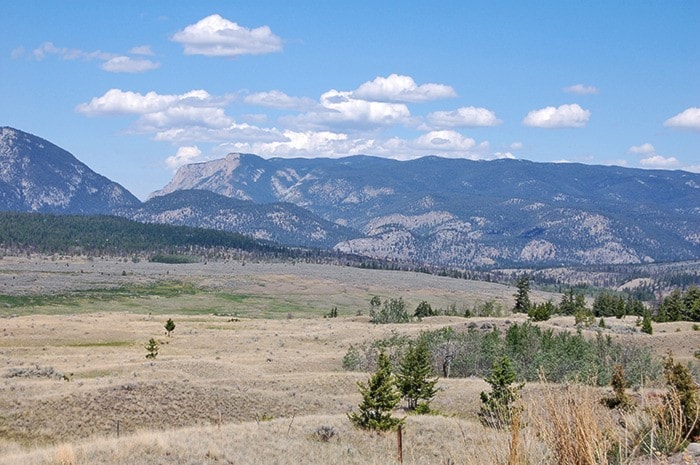It was Thomas “Doc” English who made the gruesome discovery, while riding in the mountains near Tommy Pocock’s place in Hat Creek Valley in September 1905. Something dullish-white and round attracted his attention, and he dismounted to take a better look. History does not record what he said when he realized he was looking at a human skull; all we know is that he reported his find to the authorities in Ashcroft, who put two and two together and came to the conclusion that the mystery of George Finney’s disappearance five years earlier had apparently been solved.
But my story is getting ahead of itself. We must go back; back further than 1900, when Finney disappeared, all the way to 1877, when it was discovered that there was coal in Hat Creek Valley. The area had already attracted cattle drovers and packers, who started coming there with their herds in the 1860s, anxious to supply beef to the prospective miners flocking to the goldfields. By the 1880s, with the goldfields played out, Hat Creek was attracting homesteaders, who settled down in the valley to ranch and farm.
But the riches to be had above ground in Hat Creek paled in comparison to what lay beneath its fertile soil. The coalfield found in 1877 was huge, although no one then knew the true extent of it. Such potential was sure to attract the attention of someone enterprising enough to try to get at it; and that person turned out to be George Finney.
Finney was born in England in 1852 and emigrated to Canada sometime after 1881 (he is not listed in the Canadian census of that year). Then as now, the census was carried out every 10 years; and in the 1891 census Finney is recorded as living in Hat Creek Valley. The record shows that he was a bachelor, and that his “Profession, Occupation, or Trade” was given as “Colliery and Carpenter”.
He lived at the northern end of the valley, near Marble Canyon, and was known to keep a few horses. He had also established a sawmill – hence the “carpenter” – and was clearly already at work trying to extract coal from Hat Creek, as the “colliery” designation shows. By 1893 he had succeeded in establishing a small and rather crude coal operation, in partnership with Charles McNichol. The men used a huge windlass, operated by horse power (the original kind), to extract coal from the shaft. The coal was sold to ranchers living in the vicinity, and at regular intervals Finney would load a wagon and drive in to Ashcroft, where there was a limited market for the fruits of his labour. It would have been a long and arduous drive from Hat Creek to Ashcroft in those days, and Finney – who seems to have been a solitary sort of man – doubtless looked on the journey as something of a chore.
Perhaps that’s why, during his trip to Ashcroft in late August 1900, Finney imbibed rather more alcohol than was good for him. When he left Ashcroft on Aug. 25 he was described as “intoxicated”, and it was known that he was taking several bottles of liquor back to Hat Creek with him. Why he set out on a long and difficult journey in such a state is something we will never know. What we do know, however, is that Finney never made it back to his home in Hat Creek.
It took some time for the word to get out that Finney was missing. It was not until Sept. 15 that The Journal reported the matter, stating that “George Finney, of Hat Creek, has been missing from his home since the 25th of August. Previous to that date he spent some time in Ashcroft, and the last seen of him was by Indians on the Hat Creek trail about seven miles from Ashcroft. He had been drinking and it is possible has wandered from the trail and died of exposure. Government Agent [Joe] Burr is directing a search for him.”
The search was in vain. A week later The Journal reported that “No trace has yet been found of Geo. Finney. Henry Cargile, who is conducting a search for him, is of the opinion that he has perished in a mud hole, of which there are many in the vicinity of where he was last seen.”
Two weeks after that, an appeal for information was made by Ashcroft lawyer Stuart Henderson. A paragraph in The Journal informs the public that “Twenty-five dollars reward will be paid by me to the person who finds George Finney, last seen August 25. Stuart Henderson, Ashcroft, Sept. 21 1900.”
The appeal was in vain. No further trace was found of George Finney until Doc English came across the skull five years later. “Now the mystery may in part be cleared up,” stated The Journal, continuing that the skull’s location “would indicate that it came from the mountain above, either by rolling down or being carried by a wild animal. No other part of the body or the remains of the horse, which Finney was known to be riding, were visible, which bears out the supposition that farther up the mountain may be found evidence of how Finney died.”
George Finney had lived in the area for more than a decade, and would have known every inch of the trail between Hat Creek and Ashcroft. Yet he disappeared so completely that searchers could find no trace of him, and it was only by chance that his skull – if it was indeed that of George Finney – was found some five years later. The mystery of what happened to him, that night in August 1900, is forever buried in the mountains which claimed his life.
Barbara Roden
